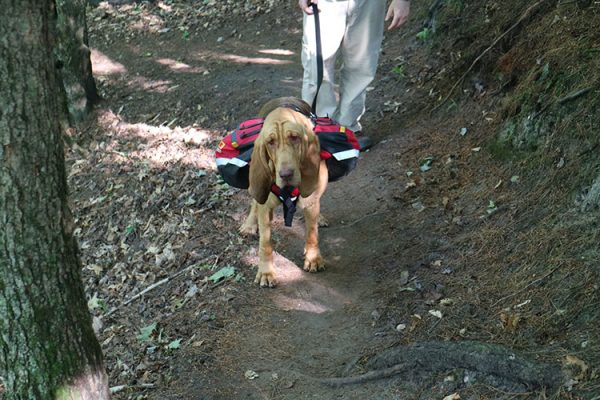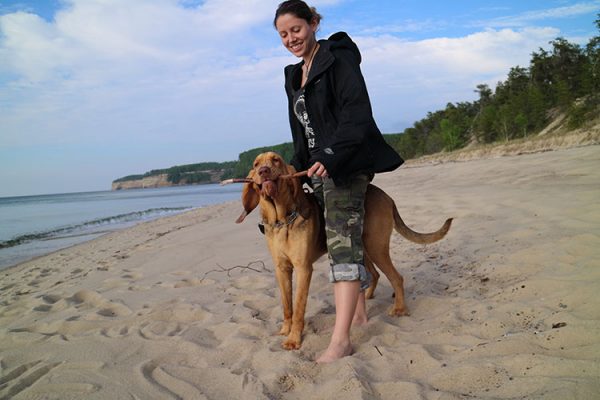Backpacking with your dog isn’t a simple matter of slapping a leash on and setting out into the woods. There should be a lot more preparation that goes into it than that.
Going backpacking with my dog has hands down been the most rewarding bonding experience an owner and her faithful companion could possibly ask for. I can’t think of any other activity that would have quite the same effect. I’ve spent many an hour strolling alongside my pup, slipping her treats and telling her what a good girl she is.
But that’s not to say it’s for everyone. It’s my firm belief that not every dog is cut out for covering the ground required to make it in the backcountry. These are some of the considerations to ponder before taking your furry friend into the wilderness with you…

TRAINING:
Just like us, a dog can’t simply be plopped onto the trail and immediately become a star long distance hiker. They need conditioning that gradually works them up to the distance you hope to hike. Otherwise, your dog my get injured or become sore. I’d recommend working up to no more than five miles per day for your first hike, but of course try this in areas near your home first to make sure your four-legged friend can go the distance.
PAW COMFORT:
It’s also important to toughen up their paws by hiking on surfaces similar to where you plan to backpack. Regardless of how tough you believe your dogs paws are, there are certain terrains that wouldn’t be good for your dogs feet even if they have been somewhat conditioned. Because we use sturdy hiking boots to overcome rocky trails with roots, pine needles, and more, we often forget that Fido is barefoot and is vulnerable to more than we are.

There are dog booties you can buy or make yourself (post on this to come!) to protect your dogs paws. Not only will your dog be better off in the long run for it, but you’ll get many laughs watching your dog dance around imaginary egg shells the first few times he tries them. In time he’ll get used to them and may even come to love his dog booties!
It’s also important to keep your dogs nails trimmed short prior to departing for the trip, as excessively long ones can rub the sides of the paw raw and cause extreme discomfort.
DOGGY GEAR:
Depending on how big your dog is, you may want to consider giving Fido his fair share of gear. Some dog breeds actually love carrying a backpack because they’re bred to pull things–some dogs can’t stand it. There are many high quality dog packs designed to evenly distribute weight. You don’t want to pack any more than about 25% of your dogs body weight. We fill our dog Maggie Mae’s pack with her water, lightweight dog bowls, food, and blanket–but she’s a big girl!

Just as with the booties, make sure you give your dog ample practice walking with the pack, as it can take time to get used to moving with the added weight and gracefully passing trees and other objects. Watch your dogs underarms and belly for signs of chafing or redness to make sure the backpack is adjusted and fitted properly.
WILDLIFE:
Another factor to consider is the wildlife in the area you’re planning to explore. In areas with large predators such as grizzly bears or wolves, remember that wildlife can be intrigued by the smell of another animal in their territory. Depending on the animal, your dog could either be an attractant or a deterrent for an intruder you probably don’t want sniffing around your camp. With a dog, you must take extra diligence to be sure there are no kibbles left on the ground in or near camp after meals.

Not only that, but there are smaller threats to take into account as well, such as ticks or poisonous plants. Dogs don’t have long pants and sleeves to protect their limbs and are often walking through the thickest of areas that we humans don’t need to worry about.
FIRST AID:
Having dog first-aid on hand is imperative. Some items to include would be liquid bandage spray, gauze rolls, alcohol wipes, and tick remover forceps.
WATER:

Dogs, like humans, can be affected by bacteria in the water. Never let your dog drink right from a lake or stream in large quantities. Whenever cleaning water for yourself, be sure to treat some to keep your canine buddy safe and healthy as well!
SLEEPING ARRANGEMENTS:

Although dogs don’t normally sleep with blankets at home, consider the location you’ll be visiting and how chilly it may get throughout the night. If you don’t want Fido snuggling into your sleeping bag with you, definitely bring a warm blanket and maybe even a piece of foam to keep the floor of the tent comfy for bedtime. With a medium to large sized dog, account for another person in the tent and make sure it’s big enough for a much needed stretch after a long day of hiking.
OVERALL:
After a few weeks of working toward a successful backpacking experience for the both of you, seriously consider whether backpacking is right for your pup. Dogs should be fully grown before embarking on their first backcountry adventure and be in generally good health. Excessive distances are not safe for small breeds or dogs with impending hip or joint problems. If your dog still refuses to go further than a mile or two after a few weeks of attempted conditioning, hiking simply may not be his cup of tea. Not all humans like backpacking, so that means not all dogs will either–it takes a certain personalty type to revel in the remoteness, exhaustion, and lack of cleanliness that comes with backpacking.

However, if your dog is like you and I–a glutton for punishment with a love for the outdoors and the physical ability required for overnight backpacking, a trip into the wilderness may be just what you need to take your relationship to the next level. My dog, for one, would much rather be enjoying the great outdoors with me than sitting in a kennel somewhere. Our next backcountry adventure will be to the Porcupine Mountains in Michigan’s Upper Peninsula and we can’t wait to share it with you!
Do you have any specific questions or tips about backpacking with your dog? I’d love to read them in the comments. When it comes to my Maggie Mae, I could go on forever!
Forever Trekking,
CAITLYN WITHOUT A COMPASS



Leave a Reply